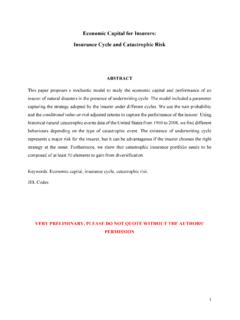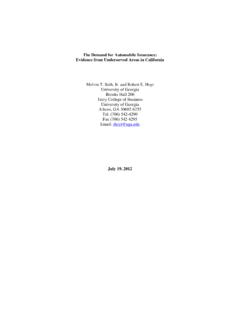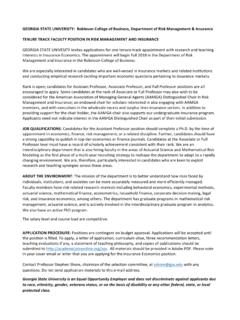Transcription of A Note on Capital Allocation by Percentile Layer
1 A Note on Capital Allocation by Percentile LayerLiang HONG, PhD, FSA1 AbstractCapital Allocation by Percentile Layer is a relatively new method. It can generatedifferent Capital Allocation than other popular methods such as Co-VaR, AlternativeCoVaR and CoTVAR. We compare these four methods formally. We find that capitalallocation by Percentile layers does not always assign Capital in the most reasonable particular, we demonstrate that the advantage of Capital Allocation by percentilelayer depends on the target VaR. Thus, it is not always the right Capital allocationmethod. The results of this paper will help actuaries and other financial risk analyststo make judicious choices between these Classi cation:G22, G31;Keywords: Capital Allocation ; Percentile Layer ; Co-VaR; Alternative CoVaR; CoTVaR;VaR-dependence1 Liang Hong is Fellow of Society of Actuaries (SOA) and Assistant Professor of Mathematics &Actuarial Science in the Department of Mathematics, Bradley University, 1501 West Bradley Avenue,Peoria, IL 61625, USA.
2 Tel.: (309) 677-2508; fax: (309) 677-3999. Email address: IntroductionCapital Allocation is part of Capital budgeting decision for all financial entities. Appro-priate Capital Allocation is essential for greater financial strength and better enterpriserisk management (ERM). Actuaries and ERM analysts have been interested in this topicfor a long time. Tasche (2000) studied the risk-adjusted performance measurement fora portfolio. Meyer and Read (2001) used option pricing techniques to allocate capitalcross lines of business. Zanjani (2002) discussed the pricing and Capital Allocation issuesin catastrophe insurance when taking into consideration solvency, Capital cost and theuncertain of average loss. Gr undl and Schmeiser (2007) pointed out that the modelproposed by Stewart and James may not work appropriately when frictional costs needto be covered.
3 Wang (2002) introduced a coherent method of allocating Capital amongbusiness units. Laeven and Goovaerts (2003) gave an approach to determine economiccapital at an aggregate level and then to optimally allocate this amount. Kreps (2005)proposed a general formula of risk load for total cash flows which is additive. Kalkbrener(2005) proposed some an axiomatic system for Capital Allocation . Using HahnBanachtheorem in functional analysis, he showed that for every subadditive and positively ho-mogeneous risk measure, there exists a Capital Allocation that satisfies the main (2004) and Venter (2009) summarized all the important methods for Capital al-location. Venter (2010) addressed the Capital Allocation for non-tail risks. Salam (2010)used the Lagrange multipliers to optimize Capital Allocation so as to maximize expectednet after-tax value of a (2007) introduced an innovative method to allocate capitals by percentilelayers.
4 He used a numerical example to show that Percentile Layer method is morereasonable than three other popular methods: the Co-VaR method, Alternative CoVaRmethod and CoTVAR method. This new method certainly gives insurance companiesmore options when facing the decision to allocate Capital for different lines of , one will wonder whether the result in Bodoff (2007) holds in general afterreading Bodoff (2007). Namely, one wants to know the answer to the following question:Question 1: Does Percentile Layer method always assign Capital in a more reasonable2manner than other methods?2 The example in Bodoff (2007) makes it seem like the answer to Question 1 is , in this paper, we will show that the answer to the above question is precisely, the advantage of Percentile Layer method depends on the target easy reference and comparison, we will adopt the same scope of problem inBodoff (2007).
5 In particular, we will restrict our study to a publicly trade insurancefirm that writes both insurance and reinsurance polices on two catastrophic perils. Weassume the firm will hold Capital at a target remaining of the paper is organized as follows. In Section 2, we compare the fourmethods for a given VaR, and discuss the advantages and drawbacks of each Section 3, we compare the four methods for a different target VaR, and concludethat the advantages of Capital Allocation by Percentile depends on the target VaR. Inparticular, we give an example to show that Percentile Layer method is not always theright Capital Allocation method. Section 4 concludes the paper with a summary. Section5 is an appendix that contains essential technical details of Section Comparison of Percentile Layer Method with Co-VaR Method, Alternative CoVaR Method andCoTVAR MethodFori= 1;2, we will use the following notations:Ei: thei-th loss : the occurrence probability ofi-th loss this paper, we say a method of Capital Allocation isreasonableif it assigns Capital to all perilsand it assigns more Capital to peril 1 than peril 2 when the mean loss of peril 1 is larger than that ofperil : the corresponding loss amount resulting from the : the amount of Capital allocated to thei-th in Bodoff (2007), we assumeE1andE2are independent.
6 Without loss of generality,we assume 0< L1< L2. The insurer needs to consider four possible events:(1)neitherE1norE2occurs, \Ec2;(2)onlyE1occurs, \Ec2;(3)onlyE2occurs, \E2;(4)both events occur, \ following Table 1 gives the distribution of all these 1: Distribution of all possible eventsEventProbability Cumulative Probability Total LossEc1\Ec2(1 p1)(1 p2)(1 p1)(1 p2)0E1\Ec2p1(1 p2)(1 p2)L1Ec1\E2(1 p1)p21 p1p2L2E1\E2p1p2100%L1+L2 Suppose the insurance firm holds Capital at VaR(1 p1p2), then the amount of capitalto be held isL2. Under this condition, we will compare the Capital Allocation suggestedby the four methods. Note that the illustrating example given in Bodoff (2007) is aspecial case withp1= 20%; p2= 5%; L1= 99 M andL2= 100 CoVaR MethodUnder the CoVaR method, the firm will allocate allL2of Capital to the VaR(1 p1p2)scenario.
7 In other word, theL2of Capital will go entirely to the second peril, and thefirst peril will receive zero Alternative CoVaR MethodAlternative CoVaR method suggests that the firm should allocateL2of Capital to allevents V aR(1 p1p2) according to their conditional probabilities. Specifically, The firm will allocateL2 (1 p1)p2(1 p1)p2+p1p2= (1 p1)L2of Capital to the eventEc1\E2andL2 p1p2(1 p1)p2+p1p2=p1L2of Capital to the eventE1\E2. For the latter, the firm further allocates the Capital to the two perils according totheir loss amounts. In other words, amongp1L2of Capital , (p1L2) L1L1+L2=p1L1L2L1+L2will go to the first peril while the remainingp1L22L1+L2will go to the secondperil. In total, the Capital allocated to the two perils areC1=p1L1L2L1+L2;(1)C2= (1 p2)L2+p1L22L1+L2=L2[(L1+L2) L1p1]L1+L2 CoTVaR MethodUsing CoTVaR method, the firm will allocateL2of Capital to all events V aR(1 p1p2)according to their conditional expected losses.
8 Specifically, The firm will allocateL2 (1 p1)p2 L2(1 p1)p2 L2+p1p2 (L1+L2)=(1 p1)L22p1L1+L2of Capital to the eventEc1\E2andL2 p1p2 (L1+L2)(1 p1)p2 L2+p1p2 (L1+L2)=p1L2(L1+L2)p1L1+L2of Capital to the eventE1\E2. For the latter event, further Allocation among the two perils will be based on theloss amount of the perils. In other words, amongp1L2(L1+L2)p1L1+L2of Capital , the5first peril will receivep1L2(L1+L2)p1L1+L2 L1L1+L2=p1L1L2p1L1+L2of Capital , and thesecond peril getp1L2(L1+L2)p1L1+L2 L2L1+L2=p1L22p1L1+L2of Capital . Thus, the total amounts of Capital allocated to the two perils will beC1=p1L1L2p1L1+L2;(2)C2=(1 p1)L22p1L1+L2+p1L22p1L1+L2=L22p1L1+L2 Capital Allocation by Percentile LayerFrom Table 1, we know there are three Percentile layers of Capital :(1)The Percentile Layer of Capital ((1 p1)(1 p2);(1 p2)) =L1 0 =L1.
9 (2)The Percentile Layer of Capital ((1 p2);1 p1p2) =L2 L1.(3)The Percentile Layer of Capital (1 p1p2;100%) = (L1+L2) L2= will useCji;(i= 1;2; j= 1;2;3) to denote the amount of Capital allocated toi-thperil forj-th Layer of Capital . To allocate Capital by Percentile Layer , the firm will allocatezero Capital to any Layer of Capital that exceeds the targetV aR(1 p1p2). For otherlayers of Capital , the firm will allocate Capital only to those events that penetrate thelayers. For an event penetrating a specific Layer , the amount of Capital the event will getis based on its conditional exceedance probability. Specifically, The firm will not allocate any Capital to the third Layer because it exceeds thetargetV aR(1 p1p2). The second Layer are penetrated only by two events:Ec1\E2andE1\E2.
10 TheeventEc1\E2will get (L2 L1) (1 p1)p2(1 p1)p2+p1p2= (1 p1)(L2 L1) of , the eventE1\E2will get (L2 L1) p1p2(1 p1)p2+p1p2=p1(L2 L1) of6capital. For the latter, further Allocation is still based on the loss amount. Thus,the first peril will getp1(L2 L1) L1L1+L2=p1L1(L2 L1)L1+L2of Capital and thesecond peril will getp1(L2 L1) L2L1+L2=p1L2(L1 L1)L1+L2of Capital . Therefore,the total amounts of Capital allocated to the two perils in the second Layer areC21=p1L1(L2 L1)L1+L2;(3)C22= (1 p1)(L2 L1) +p1L2(L1 L1)L1+L2=(L2 L1)[(1 p1)L1+L2]L1+L2: The first Layer are penetrated by three events:E1\Ec2,Ec1\E2andE1\ before, the eventE1\Ec2will receiveL1 p1(1 p2)p1(1 p2) + (1 p1)p2+p1p2=p1(1 p2)L1p1 p1p2+p2of Capital , the eventEc1\E2willreceiveL1 (1 p1)p2p1(1 p2) + (1 p1)p2+p1p2=(1 p1)p2L1p1 p1p2+p2of Capital , and theeventEc1\E2will receiveL1 p1p2p1(1 p2) + (1 p1)p2+p1p2=p1p2L1p1 p1p2+p2of Capital .













